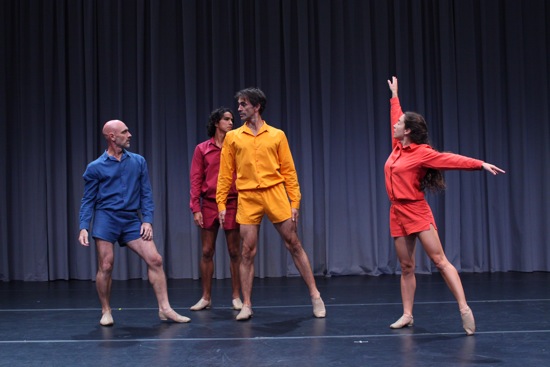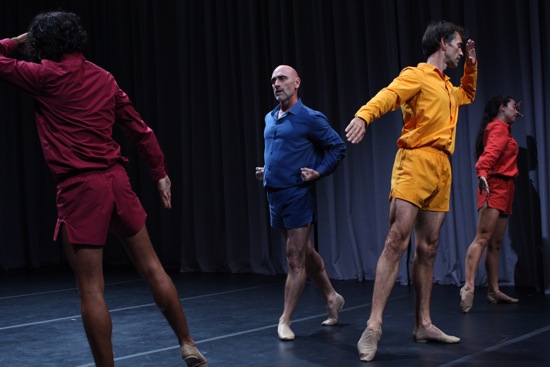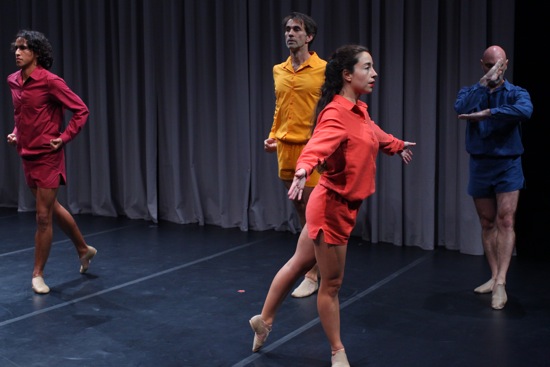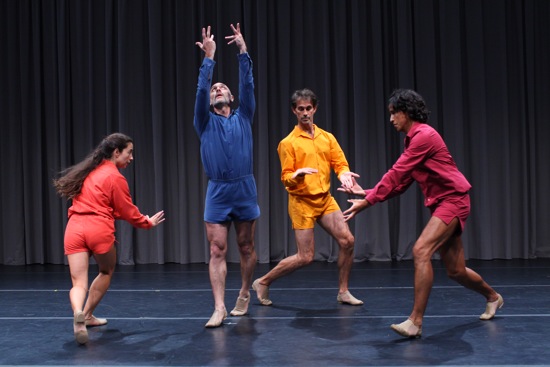
(L to R) Walter Dundervill, Fabian Barba, Nuno Bizarro, and Naiara Mendioroz of DD Dorvillier/human future dance corps in Danza Permanente. Photo: Paula Court
DD Dorvillier’s dances seem to be built upon propositions (What if I limited my self to this? What if I examined an idea through an unusual lens?). Usually she imbues her works with wit and an offbeat theatricality that together play against the limits of the choreographic structure. Translation is a theme that runs through her recent works. In her No Change or “freedom is a psycho-kinetic skill” (2007), she adventured in a field of objects and sonic equipment that affected her movements and sometimes translated them into sounds. Different spoken languages came into play in Choreography, a Prologue for the Apocalypse of Understanding, Get Ready! (2009); in addition, four dancers made simple gestures corresponding to the pitch of certain sounds in Zeena Parkins’s live score.
Dorvillier’s new piece—more demurely titled Danza Permanente—took that pleasant experiment and expanded it into challenging and treacherous new territory. I say “treacherous” because this time her challenge was to examine the score of Beethoven’s String Quartet #15 and translate its structure and rhythms into movements for four dancers—each representing one of the four instruments. You mess with Beethoven at your peril. When Trisha Brown choreographed M.O. in 1995 (the first time she tackled a musical classic), she studied the score of J.S. Bach’s Musical Offering intensively and built her structure on that of the music, ignoring its familiar melodies. But M.O. was performed to the music.
Dorvillier, too, apparently thought that it would be crazy to represent the melodic lines familiar to lovers of Beethoven. However—perhaps in part because Beethoven was completely deaf by the time he composed his fifteenth quartet (1825)—she decided that the audience at the Kitchen (September 26 through 30) would not hear it either; through the dancers’ movements and the sound of feet on the floor, they would absorb the quartet visually (she said last week that she had not, in the end, produced a replica of the music). In addition, she selected four words to translate at times into gestures; they’re grand ones: geburt (birth), schule (school), arbeit (work), tod (death). We hear these spoken occasionally by recorded voices or unseen live ones. The gestures aren’t literal; you’d never guess what they referred to in a game of charades. Work for instance, is expressed by the dancer lunging moderately to the side, the back of one hand against his or her brow, the other hand held slightly away from the body on the opposite side, fingers pointing down. Softened a little, the move could translate as wiping away sweat or sinking into grief, but it remains a two-dimensional design.
The Kitchen’s performing area has been draped with grayish curtains along the sides and back. Michelle Amet costumed the dancers in short pants and matching long-sleeved jackets in saturated colors: coral (Naiara Mendioroz, violin 1); deeper pink (Fabian Barba, violin 2; egg-yolk yellow (Nuno Bizarro, viola); deep blue (Walter Dundervill, cello). The dancers’ feet aren’t the only sound. Parkins, who provided musical direction and analysis during the creative process, creates a subtle, intermittent “acoustic environment.” Sometimes the sounds are soft whirrings and chirpings; sometimes they rumble. A school bell rings. A siren wails.
At first—and for some time—I found the dance extremely absorbing. You don’t just watch it; you study it. At times, I think I hear a ghost of the music alluded to through the rhythms (a clearly marked ¾ time, for example) or the dynamics of the movement (a Beethovenian build-up in terms of short escalating repetitions is very clear). The steps are not virtuosic; no high kicks or whizzing turns. No big leaps, but occasional jumps. The performers walk, march, gallop, step slowly, lunge, form positions in very deliberate, studious ways. Occasionally, a ripple of the notes we don’t hear elicits a rush of tiny tiptoe steps, or a flicking of hands in the air. During the last of Beethoven’s five movements (Allegro Appassionato, Presto), the dancers run in and out of openings in the curtain, making them billow and adding turbulence to the otherwise even-tempered choreography. Thomas Dunn’s lighting also dramatizes the environment.
Now and then, one or more people pause briefly. At least once, Mendioroz kites off on her own, distancing herself from the others for a few seconds. Rules of some kind govern the performers’ formations and their facings, although I’m not sure what those rules are. Some aspect of the written score must cause the four to form a shoulder–to-shoulder line, or draws them toward one corner of the space. Perhaps changing key signatures affect the design. Rarely, of course, are the dancers in unison, but—especially when they repeat a theme—you perceive their different patterns as blending within a whole. The whole experience is like watching a puzzle you strain to understand.
The dancers’ differences have an effect on your perception. Dundervill is the most intent, decisive, aware of the others. Tall, lean Bizarro dances gravely. The younger Barba, with his flying curls, is looser than either of them, and Mendioroz, appropriately, is the lightest of the four.
The task of translating musical structure into dance movements hits a stumbling block. Four melodies weaving together create a sonic tapestry. Four single tones may blend into a single tone. But four dancers executing the same movement do not look like one big dancer. So visual harmony equivalent to Beethoven’s aural one isn’t possible. Making the dancers’ “voices” weave together may not even be something Dorvillier tried to do. You can see that they know they’re making something together (and that their task is a very difficult one), but even though they cut circular or linear paths around one another, the four of them don’t appear profoundly related. And they almost never touch or come very close together. Is this perhaps because the musicians playing a string quartet maintain their distance from one another on separate chairs?
In an interview printed in the New York Times, Dorvillier spoke of being “transported” when she closes her eyes and listens to the Beethoven quartet, and that the music somehow epitomizes the “merging of thinking and feeling” that drives her to make work. She also contributed this statement in an article about Danza Permanente that appeared in a recent issue of Artforum: “I wanted to investigate how music functions in relation to feelingness and thought, how it produces meaning and a sense of drama through its structure.”
But Danza Permanente doesn’t convey a sense of drama through its structure, even during the long, beautiful third movement, Molto Adagio; Andante (conceived by Beethoven as a song—in the Lydian mode— giving thanks to God for the composer’s recovery from a near-death illness). The music is slow, with faster interludes, and the dancers begin with a smooth gesture of lifting their hands, palms up, as if making an offering. Throughout Danza Permanente, however, the movement is rarely sustained, drawn out, or made fluid. Toward the last part of the work (nearly an hour long), my attention wanes, returns, wanes again. Much about the choreography and the performing seems to be understated.
In the final minutes, a voice is saying “arbeit!” over and over, and translating it for us. Indeed, if Danza Permanente is stirring at all, it’s because the hard work the dancers have put—and are putting— into it is its strongest theme. They have much to remember, figure out, keep going with. Sweat drenches their costumes, runs down their faces. You feel for them and their ordeal in creating, rehearsing, and performing this piece. Beethoven, then, was just the goad; he lent Dorvillier a structure, and she ran with it. Much as she loves the string quartet, the feelings and enigmatic dramas that emanate from the music rarely color the dancing.




And now I’m wishing that I could have seen some of St Denis’ music visualization works, to get a better sense of how they worked. Even if you feel that Dorvillier’s work didn’t do what she had hoped, it sounds like a fascinating experiment.
As a former English teacher, I have long found that the basic tenet of what was called the New Criticism made sense in all the arts, that it is the work that is important, not the intention, the artist’s biography, or many other such matters. In reading about Dorvillier’s Danza Permanente , which I haven’t seen, it strikes me that it would have been much more interesting if she had presented the work without revealing her process, which she might have then discussed afterward. But given all the publicity she and her process have generated, there is no way that the work could be evaluated for itself.
While it strikes me as a strange decision to work as she has, there are many works of art that come from unexpected sources and modes of working. Process can indeed be fascinating and when known is important for understanding the artist, which is quite a different matter,while at times a few words in a program note have indeed opened a work to me that was previously closed or unclear. Finally, though, a work of art must stand by itself and I would suggest that all of the information about Beethoven’s quartet (a work that has meant a great deal to me since I first heard a recording of it when I was about 19) has called far too much attention to itself and to her mode of working, rather than allowing the viewer to focus on the dance, which is what finally matters.